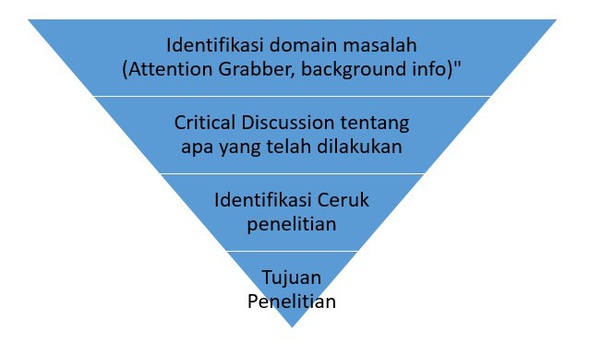Haha, I deliberately reread and double-checked to ensure my knowledge stays updated while answering questions here on Quora.
Start with general aspects of the topic at the beginning of the introduction, then gradually narrow it down to more specific information, eventually leading clearly to your research question or research objectives. If possible, the potential outcomes of the research can be briefly mentioned as a teaser or trailer.
Identifying the Problem Domain (Attention grabber and background info):
Emphasize the importance of the topic; make general statements about it; provide an overview of recent research on the subject being studied.
Critical Discussion of Previous Research:
Provide a balanced, concise review of related literature, books, or journal articles. The strategy here is to summarize the literature briefly so readers understand the research problems that existed before you conduct your own analysis. This part of the introduction should not contain a comprehensive literature review (which will appear in Chapter 2). It should instead be a brief overview of key foundational research literature (with citations) necessary for readers to understand your research problem and upcoming study.
Identifying the Research Gap:
Closely related to the critical discussion above, identify the research gap by challenging existing assumptions, highlighting gaps in previous studies, and clearly stating your research question or problem. Position your research within this gap by stating the purpose of your study, outlining its main characteristics, and ending with:
Research Objectives
NOTE 1:
You should not only clearly define what you intend to research or achieve but also explicitly state what will not be covered in your study. This is crucial to prevent questions beyond your research interest and topic. It also serves as a subtle warning to examiners who tend to ask questions outside your research context.
NOTE 2:
Although the introduction appears at the beginning (of course, that's why it’s called an introduction; if it came last, it would be called regret! Haha, just kidding), it’s often helpful to finalize your introduction last. This finalization involves polishing the introduction to accurately reflect the structure of your thesis, the reporting and analysis of findings, and your conclusion. In other words, your introduction should align perfectly with the overall structure of your thesis.
NOTE 3:
Don't confuse "scope delimitations" (pembatasan) with "limitations" (keterbatasan). Scope delimitations usually appear in the Introduction chapter, whereas limitations appear in the Discussion chapter and Conclusions chapter, highlighting constraints you identified after conducting the research. (I'll explain this more clearly when I talk about Conclusions and Recommendations.)
NOTE 4:
Your introduction must clearly identify the research area. A simple strategy is to include keywords from your title in the first few sentences of your introduction. This helps you to clearly define and maintain focus on your primary topic, ensuring you do not drift into overly general or irrelevant information.
Would anyone like to add anything to improve this explanation? I’ll include your suggestions in this answer. Thank you! 🙏🏾🙏🏾
I HOPE THIS IS USEFUL FOR BOTH YOU AND ME!

